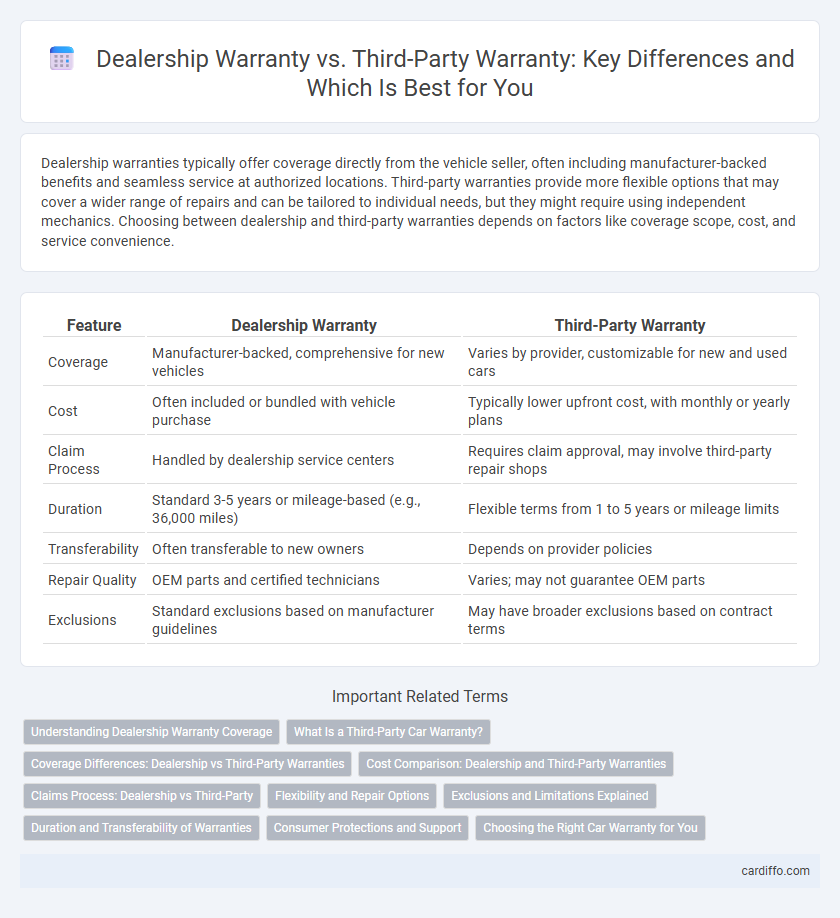Dealership warranties typically offer coverage directly from the vehicle seller, often including manufacturer-backed benefits and seamless service at authorized locations. Third-party warranties provide more flexible options that may cover a wider range of repairs and can be tailored to individual needs, but they might require using independent mechanics. Choosing between dealership and third-party warranties depends on factors like coverage scope, cost, and service convenience.
Table of Comparison
| Feature | Dealership Warranty | Third-Party Warranty |
|---|---|---|
| Coverage | Manufacturer-backed, comprehensive for new vehicles | Varies by provider, customizable for new and used cars |
| Cost | Often included or bundled with vehicle purchase | Typically lower upfront cost, with monthly or yearly plans |
| Claim Process | Handled by dealership service centers | Requires claim approval, may involve third-party repair shops |
| Duration | Standard 3-5 years or mileage-based (e.g., 36,000 miles) | Flexible terms from 1 to 5 years or mileage limits |
| Transferability | Often transferable to new owners | Depends on provider policies |
| Repair Quality | OEM parts and certified technicians | Varies; may not guarantee OEM parts |
| Exclusions | Standard exclusions based on manufacturer guidelines | May have broader exclusions based on contract terms |
Understanding Dealership Warranty Coverage
Dealership warranty coverage typically includes manufacturer-backed protection for defects in materials and workmanship, often providing comprehensive repairs and services authorized by the dealership. These warranties are usually valid for a specific duration or mileage, commonly ranging from 3 years or 36,000 miles to longer terms for certified pre-owned vehicles. Understanding the scope of dealership warranty coverage is essential, as it often covers powertrain components, electrical systems, and sometimes complimentary maintenance, ensuring authorized service quality.
What Is a Third-Party Car Warranty?
A third-party car warranty is an extended service contract purchased from a provider other than the vehicle's original manufacturer or dealership, offering coverage for repairs and maintenance beyond the standard factory warranty. These warranties often provide flexible plans tailored to different budgets and coverages, including powertrain, bumper-to-bumper, or specific components. Unlike dealership warranties, third-party warranties may allow coverage at multiple repair shops, increasing convenience and choice for vehicle owners.
Coverage Differences: Dealership vs Third-Party Warranties
Dealership warranties typically offer comprehensive coverage for both parts and labor, often including manufacturer-backed benefits like roadside assistance and repairs performed with OEM parts. Third-party warranties vary widely in coverage, sometimes excluding key components or limiting repair locations, which can lead to higher out-of-pocket costs. Evaluating the scope of coverage, claim process efficiency, and authorized service provider networks is crucial when comparing dealership versus third-party warranty options.
Cost Comparison: Dealership and Third-Party Warranties
Dealership warranties generally come with higher upfront costs but often include comprehensive coverage and maintenance services tailored to specific vehicle makes, enhancing overall value. Third-party warranties tend to offer more affordable premiums with customizable plans but may involve limited coverage and stricter claim processes. Evaluating the cost-effectiveness depends on factors like vehicle age, coverage options, and potential repair expenses.
Claims Process: Dealership vs Third-Party
Dealership warranty claims typically involve direct communication with the vehicle manufacturer through authorized service centers, ensuring genuine parts and specialized technicians handle repairs. Third-party warranty claims often require dealing with independent administrators, which may involve more documentation and longer approval times but can offer broader coverage options. Understanding the nuances of each claims process helps consumers choose the warranty that best fits their service reliability and convenience preferences.
Flexibility and Repair Options
Dealership warranties typically offer repairs at authorized service centers with OEM parts, ensuring high-quality repairs but limited flexibility in choosing service providers. Third-party warranties provide more flexibility by allowing repairs at a wider range of repair shops, often including independent mechanics, which can result in varied repair options and potentially lower costs. Choosing between the two depends on the balance between guaranteed quality and the convenience or cost-effectiveness of repair services.
Exclusions and Limitations Explained
Dealership warranties often provide comprehensive coverage directly linked to vehicle repairs and manufacturer standards but typically exclude wear-and-tear parts and accidental damage. Third-party warranties may offer broader protection options yet frequently impose stricter exclusions such as pre-existing conditions and mandated service procedures. Understanding these limitations and exclusions is crucial for making informed decisions about warranty scope and coverage reliability.
Duration and Transferability of Warranties
Dealership warranties typically offer shorter durations, ranging from 3 months to 3 years, but often include benefits like free maintenance and repairs directly from the dealer. Third-party warranties can extend coverage to 5 years or more with customizable options, providing greater flexibility for transferability to new owners, which enhances vehicle resale value. Transferability of dealership warranties is usually limited or subject to dealer approval, while third-party warranties are generally designed to be fully transferable without restrictions.
Consumer Protections and Support
Dealership warranties often provide direct manufacturer-backed coverage with comprehensive consumer protections, including specific repair guarantees and authorized service support. Third-party warranties may offer more flexible plans but vary widely in coverage scope and customer service reliability, potentially affecting claim approvals and repair quality. Consumers should evaluate warranty terms carefully to ensure sufficient protections and support aligned with their vehicle's needs.
Choosing the Right Car Warranty for You
Dealership warranties often provide comprehensive coverage tailored to the specific make and model, with benefits such as certified service technicians and genuine parts, ensuring optimal vehicle maintenance. Third-party warranties offer flexible plans that may cover a wider range of repairs and can be more cost-effective for older vehicles not covered by manufacturer warranties. Evaluating your vehicle's age, driving habits, and budget helps determine whether a dealership or third-party warranty aligns best with your long-term protection needs.
Dealership Warranty vs Third-Party Warranty Infographic

 cardiffo.com
cardiffo.com